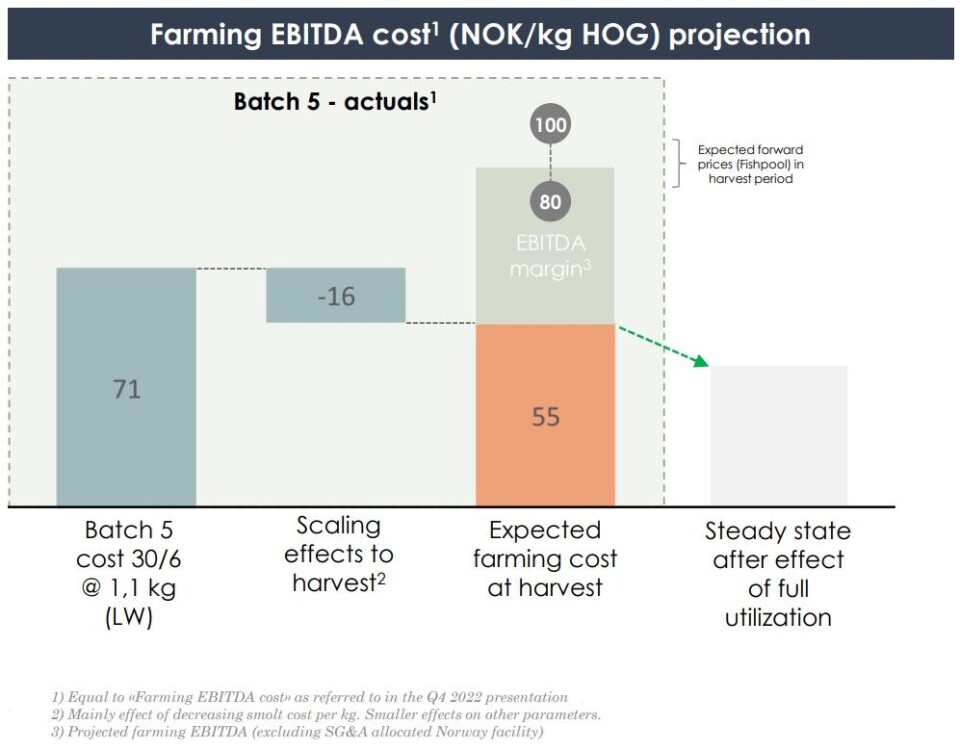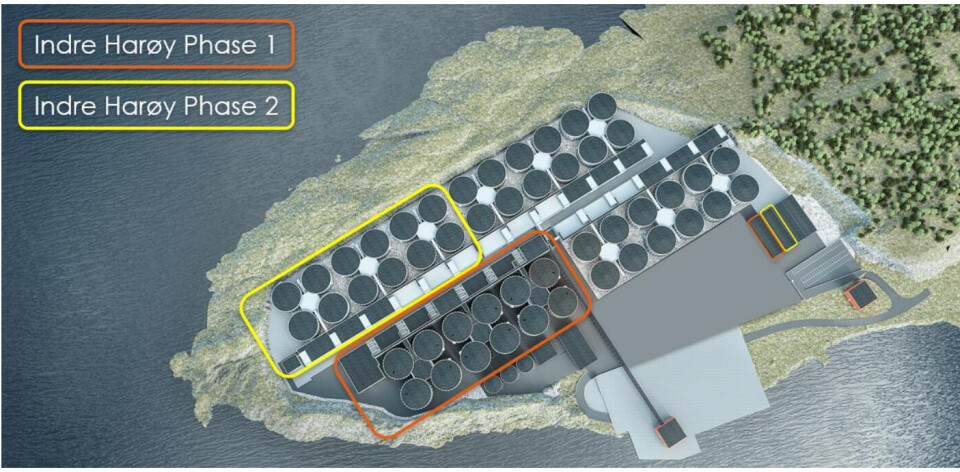
Underlying result ‘positive’ for Salmon Evolution despite Q2 loss
Land-based fish farmer points to growing biomass and falling cost per kilo
Salmon Evolution’s farming operation made negative EBITDA of NOK 5.9 million (£438,000) in the second quarter of 2023, but the underlying result was positive.
The land-based salmon farmer incurred mortality costs of NOK 12.9m due to amoebic gill disease (AGD) and spent a further NOK 5m on biosecurity measures to ensure the problem wouldn’t happen again. The mortality cost was partially offset by NOK 3.1m in an expected insurance payout.
“Adjusted for these one-off costs, the underlying result in the farming segment was positive with NOK 8.9m,” said Salmon Evolution, which operates a hybrid recirculation/flow-through facility on Harøy Island (Indre Harøy), in northern Norway.
With high biomass production and increasing volume, farming costs are reducing. Batch 5 had a farming cost of approximately NOK 71/kg (head on gutted) as of 30 June at a fish live weight of 1.1kg.
“This is a cost trend that supports stable production costs at the level of conventional farming in phase 1,” said the company.

Phase 1 has the capacity to produce 7,900 tonnes HOG of salmon annually. Phase 2, currently under way, will double capacity and Phase 3 will take it to 31,500 tonnes HOG.
The second and third phases will allow further reduction of fixed costs per kg, primarily related to personnel and other operational expenditure.
Salmon Evolution said biomass production is back on track following the AGD outbreak and biological performance has been good since mid-May with good appetite and normal mortality levels.
“Q3 is on track for all-time-high biomass production with a standing biomass of 1,628 tonnes (live weight) as of 15 August.”
Batch 2 was harvested in May and produced 585 tonnes of HOG salmon with a 93% superior share, tight weight concentration and good price realisation.
“Slaughter capacity and operating procedures were then stress tested, where the entire last batch of fish was successfully slaughtered over nine days (eight slaughter days).”
The average realised price for batch 2 was of NOK 96.2/kg.
Phase 2
Contracts have been awarded for the period for Indre Harøy phase 2.
“On completion, this will add a further 7,900 t HOG, bringing the total up to 15,800 t HOG per year.”

A successful private placement was also carried out by Salmon Evolution in April with gross proceeds of NOK 525m.
As of 30 June, available liquidity was NOK 853m, including committed unused credit facilities.
During the quarter, freshwater production was installed at Indre Harøy and is operational, and the use of fresh water has been implemented as an integral part of the fish grading process.
As of 15 August, the largest group in batch 3 had reached approximately 3.8 kg, closely followed by the largest group in batch 4 of approximately 3.6 kg, which according to the company promises good harvest weights.
Steady state production
Batches 6 and 7 were stocked in late May and late June as planned.
The company calls the production cost development favourable, and further improvements are expected together with increased production volumes.
The next harvest is due in September, and steady state annual production of 7,900 tonnes HOG is expected to be reached during Q4.
Three more smolt stockings are also planned for the rest of 2023.
Salmon Evolution is also involved in a joint venture – K Smart
Farming - with seafood giant Dongwon Industries to establish a land-based
salmon farm in South Korea, where the focus is still on design and engineering
of the facility.
Salmon Evolution also plans to build a 31,500-tonne land-based salmon farm in North America once a suitable site and partner can be found.
“Evaluation of identified potential production sites on both the American and Canadian side of the border is still ongoing. The focus is on limiting oneself to one or two qualified locations during 2H 2023, which allows for a thorough review of the location and initiation of regulatory processes,” the company said.























































